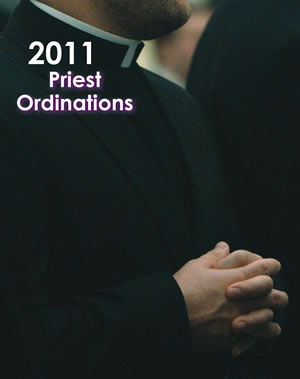
Holy orders is one of the seven sacraments. It, along with the sacrament of marriage, belongs to a special group of sacraments known as the sacraments of commitment. These two sacraments are “sacraments at the service of communion,” “directed toward the salvation of others” and “serve to build up the people of God” (Catechism of the Catholic Church, No. 1534).
Three degrees
While all of the baptized share in the universal priesthood, holy orders is the sacrament of the ordained ministry. Holy orders come in three degrees: deacon, priest or presbyter, and bishop. Only two degrees share the ministerial priesthood — bishops and priests. Priests are co-workers of the bishops, while deacons assist priests.
Ordered ministries
Holy orders is “holy” because it has a sacred character and is “ordered” because it is structured —tiered with increasing levels of responsibility. For instance, a deacon can preach and baptize, but cannot offer Mass or hear confessions; a priest can offer Mass and hear confessions, but cannot ordain; a bishop can ordain; but not only can he ordain, a bishop can perform every priestly function because he possesses the fullness of holy orders. These ministries give “holy order” to the church.
Scriptural foundations
The beginnings of the priesthood are found in the Old Testament. Melchizedek was a priest of God, the first to offer bread and wine (Genesis 14:18).
Then, beginning with Aaron, the Levites were especially chosen for priestly service (Numbers 3:5-10), and they were consecrated for this sacred duty in a carefully prescribed ordination ritual (Exodus 29; Leviticus 8). The Levites presided over the affairs of the Temple and served as mediators in the offering of sacrifice on behalf of sinners.
The priesthood of the first covenant anticipates Jesus, the one and only eternal high priest, “the one mediator between God and the human race” (1 Timothy 2:5), and ordained priests participate in his priesthood.
Instituted by Christ
The ministerial priesthood was established by Jesus when he asked his apostles to continue the ministries that he began. On Holy Thursday night when Jesus instituted the Eucharist, he told his apostles, “Do this in memory of me” (Luke 22:19).
When the risen Jesus appeared to the apostles in the Upper Room, Jesus said, “As the Father has sent me, so I send you” (John 20:21). To equip them for their commissioning, Jesus breathed on them and said, “Receive the Holy Spirit” (John 20:22).
Before Jesus ascended to heaven, he instructed the apostles, “Go, make disciples of all nations. Baptize them. Teach them” (Matthew 28:19,20). Jesus, the Good Shepherd, asked Peter to continue his shepherding duties when he said, “Feed my lambs, tend my sheep” (John 21:15,16). Jesus’ final words of instruction to his apostles were, “You will be my witnesses . . . to the ends of the earth” (Acts 1:8).
Divine call
The call to a vocation to the priesthood begins with God, not the person. The letter to the Hebrews explains, “No one takes this honor upon himself but only when called by God” (Hebrews 5:4). The priest is “taken from among men and made their representative before God,” and it is the priest’s duty “to offer gifts and sacrifices for sins” (Hebrews 5:1).
The priest serves “in persona Christi,” Latin for “in the person of Christ.” He never serves on his own behalf. Rather, Christ takes over his very being, and in his humble, loving service, he is the visible presence of Christ in the community.
Ministries of priestly office
The foremost ministries of the priest are to offer the holy sacrifice of the Mass and preach the Gospel. The Eucharist is the source and summit of Christian life; without priests, the church would have no Eucharist.
The priest is also a preacher, and he must preach first with his holiness of life, and then, and only then, with his words.
The priest is a sanctifier, a vehicle of God’s grace to the people, and the shepherd who leads the people to greater virtue and their conduit to a more intimate bond with God.
Window to God
A priest must never draw attention to himself. He is to be transparent. When the people see the priest, they should be able to see through him to God. Sin is dirt that obscures a clear view.
Each priest is called to exemplary holiness, to be a sparkling clean window so the people will be able to see past him to the true focus of their prayer and their heart’s desires, to God alone.
Father Michael Van Sloun is pastor of St. Stephen in Anoka.
Did you know?
More than $1.4 million from the 2010 Catholic Services Appeal went to support Clergy Services, which includes the St. Paul Seminary School of Divinity, St. John Vianney College Seminary, Byrne Residence and chaplains in both prisons and hospitals.
Serra clubs call for prayer for vocations before traveling monstrance
The traveling monstrance that was blessed and gifted to North America by Pope John Paul II to encourage prayers for vocations will be available in Minnesota from July 1 to July 10, sponsored by the Serra International Clubs in the Archdiocese of St. Paul and Minneapolis.
Adoration with the Blessed Sacrament is planned for June 30 and July 1 at Sacred Heart in Robbinsdale and July 5 and 6 at St. Charles Borromeo in St. Anthony. Steve Frank, with the archdiocesan Serra Clubs, said there are still openings for area parishes to host the monstrance, which will also be in the Duluth diocese July 9 and 10.
For information about hosting the monstrance, call Frank at (651)636-0600. For more about Serra Clubs, visit the website at http://serrausa.com



